Experience the Manta Ray Night Snorkel Kona – Your Ultimate Guide
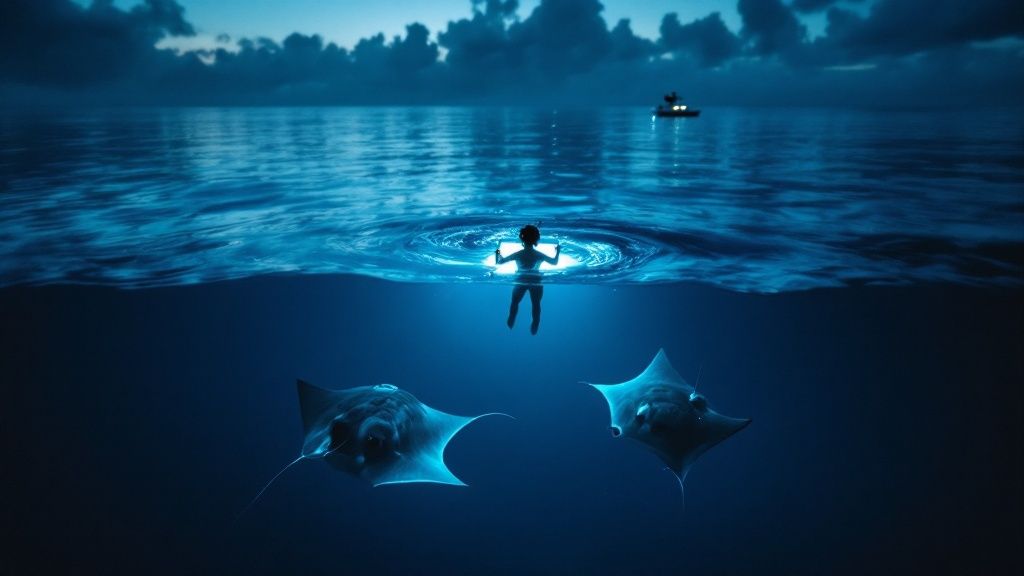
Picture this: you’re floating on the surface of the warm, dark Pacific Ocean. Below you, huge, otherworldly shapes glide through beams of light, their movements as graceful as a ballet. These gentle giants are manta rays, and this incredible, up-close encounter isn't a dream—it's the world-famous manta ray night snorkel in Kona, Hawaii.
This is more than just another snorkel trip; it's a truly bucket-list adventure. Let's dive into what makes this experience so magical and why Kona is the absolute best place on the planet to witness it.
Why Kona is the Manta Ray Capital of the World
When people talk about seeing manta rays, Kona isn't just a place to go; it's the place. The unique underwater landscape of the Kona coast has created the perfect habitat for a healthy, year-round population of reef manta rays. It's consistently ranked as one of the best night dives and snorkels in the world for a reason.
Leading the way in creating these unforgettable experiences are operators like Kona Snorkel Trips, the top rated & most reviewed snorkel company in Hawaii. They've turned this natural wonder into a safe, respectful, and mind-blowing adventure.
You’re not just watching from a distance. You have a front-row seat to one of nature’s most spectacular performances, an underwater ballet where you're part of the audience.
A Brilliant Accident: How It All Began
The secret behind the Kona manta ray snorkel is a perfect marriage of nature and a little human ingenuity. It all started decades ago when a hotel pointed lights into the surf to illuminate the coastline for its guests.
They soon noticed that the lights attracted clouds of plankton, the manta rays' favorite food. Before long, the mantas themselves started showing up for an easy buffet. It was a lightbulb moment—literally.
Tour operators realized they could recreate this phenomenon out on the open water. By shining powerful, eco-friendly lights down from the boats, they essentially create a "campfire" that draws in plankton from all around. The mantas follow the food, allowing us to witness their feeding frenzy up close without ever disrupting their natural habits.
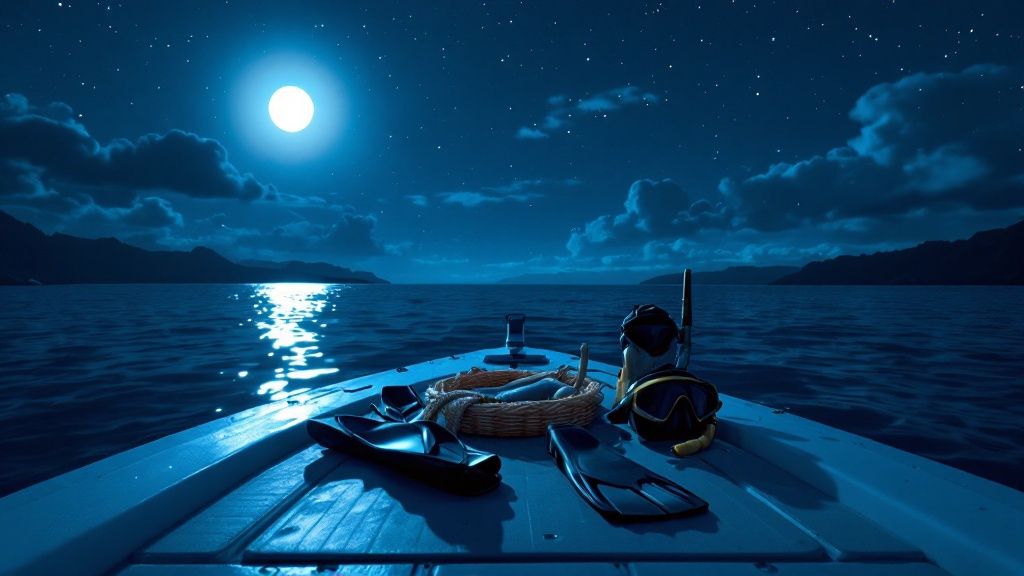
This simple but brilliant method is why Kona offers one of the most reliable wildlife encounters on Earth. The sighting success rate hovers between an incredible 85% and 90% year-round. This consistency draws about 80,000 visitors each year, making it a cornerstone of both the local economy and marine conservation efforts.
The Kona Snorkel Trips Difference
Your guide makes all the difference, and choosing the right one is key to a fantastic experience. A great tour company doesn't just motor you out to a spot in the ocean; they provide context, prioritize safety above all else, and foster a deep respect for the animals and their home.
Here's what sets the best apart:
- Expert Guidance: The crew's passion is contagious. They share fascinating facts about manta behavior and the local ecosystem, turning a cool trip into an educational one.
- Safety First: From top-notch gear and detailed safety briefings to having guides right there with you in the water, you'll feel completely secure from start to finish.
- Small Group Sizes: Forget being packed in like sardines. Smaller groups mean more personal attention and a much more intimate, awe-inspiring view of the mantas.
If you’re ready for an adventure you'll never forget, the premier manta ray night snorkel in Kona is waiting. And if you're curious about other amazing underwater spots, check out our guide to the best snorkeling in Kona, HI.
What to Expect on Your Manta Ray Tour
Your adventure begins right as the Hawaiian sun starts to kiss the horizon. After a friendly welcome and a quick check-in with the crew, you’ll head out on a scenic boat ride along the Kona coast to one of the world-famous manta viewing spots.
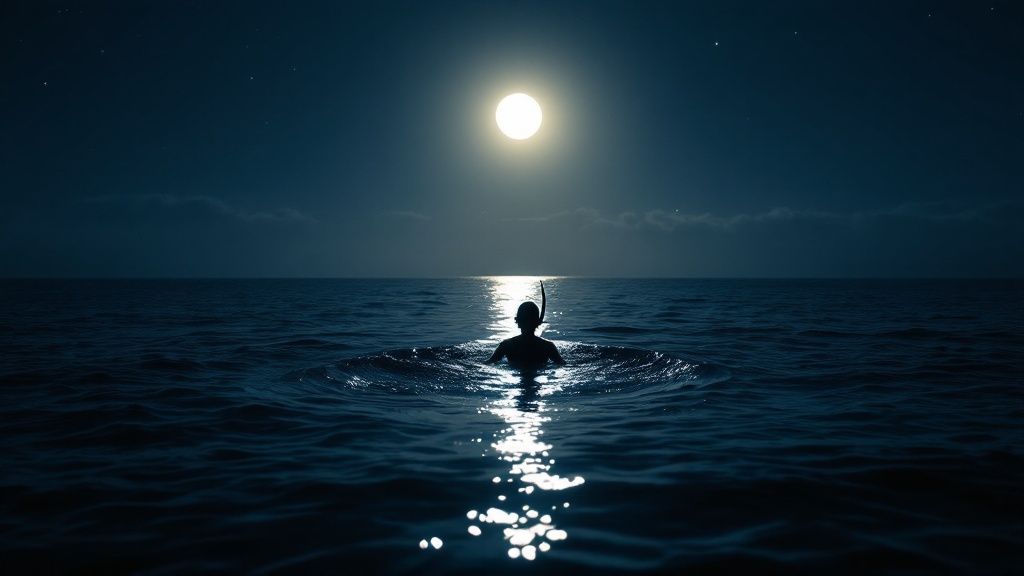
During the cruise, your guides—who live and breathe this stuff—will give you a full rundown of what's about to happen. They’ll cover everything from how to use your snorkel gear to the golden rules of manta etiquette. The goal is to make sure you feel totally comfortable and ready for the main event.
Getting in the Water
Once the boat is anchored, it’s time to hit the water. The crew will have a custom-built, floating light board waiting for you. This thing is pure genius, and it's the secret sauce to the whole experience.
- It’s a plankton magnet: The bright lights shine down into the water, attracting swarms of microscopic plankton—the manta rays' favorite meal.
- It’s your personal float: The board is super buoyant and has handles all around, so you have something sturdy to hold onto. No treading water required.
You'll slip into the surprisingly warm Pacific and find a spot at the light board. From there, your only job is to float, keep your eyes peeled, and let the magic unfold beneath you.
This isn't an active swimming event. It's all about observation. By floating quietly and holding the board, you become part of the scenery, allowing the mantas to do their thing completely undisturbed.
The Main Event
It’s hard to put into words what it feels like when that first massive, graceful shadow emerges from the deep blue. Soon, more will follow. These gentle giants arrive for their nightly buffet, and you have the best seat in the house.
You’ll watch them glide, loop, and barrel-roll just inches below you, their cavernous mouths wide open to filter the plankton from the water. It’s a silent, mesmerizing underwater ballet that feels completely out of this world. The whole experience is designed to be incredibly safe and respectful for both snorkelers and the manta rays.
If you’re ready to see this natural wonder for yourself, you can learn more about the top-rated manta ray snorkel tour in Kona. For another world-class option, Manta Ray Night Snorkel Hawaii offers an exceptional alternative that's definitely worth a look.
Meet the Gentle Giants of the Kona Coast
The real stars of the show on the manta ray night snorkel in Kona are, of course, the Reef Manta Rays (Mobula alfredi). These are massive, beautiful animals, gliding through the water with a grace that seems almost impossible for their size. It's not uncommon to see them with wingspans stretching over 12 feet wide.
Their size can be a little intimidating at first glance, but they are truly the gentle giants of the ocean.
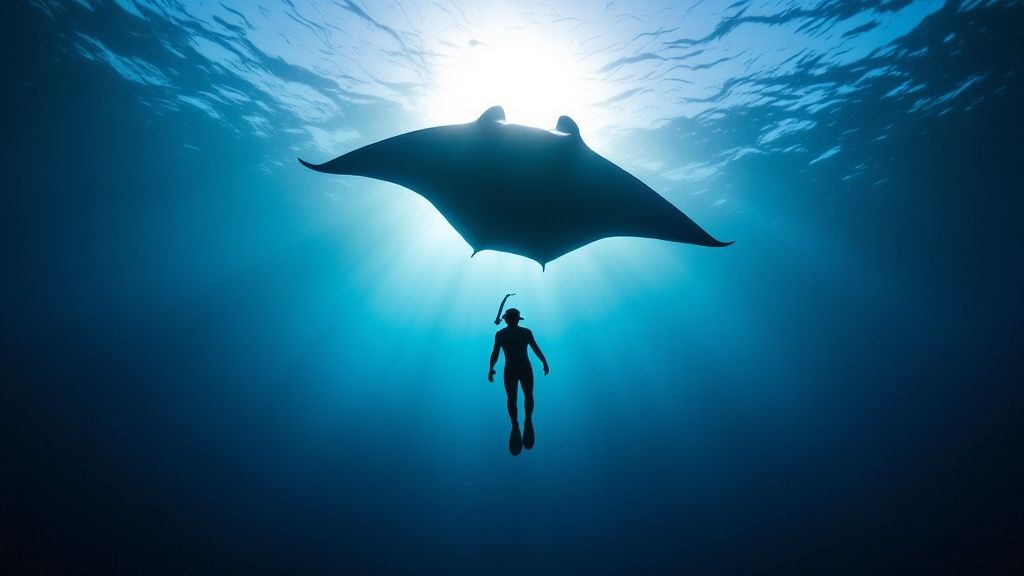
Unlike stingrays, their distant cousins, mantas are completely harmless to people. They don't have teeth, stingers, or barbs of any kind. They're filter feeders, gently scooping up huge mouthfuls of tiny plankton. Watching them feed is like seeing a slow-motion ballet unfold right in front of you.
A Unique Identity
One of the coolest things about the Kona mantas is that every single one is identifiable. The pattern of spots on their belly is as unique as a human fingerprint. This has allowed local researchers and dive guides to get to know the regulars.
Don't be surprised if you hear your guide call one out by name—like "Big Bertha" or "Lefty." It adds such a personal feel to the experience. This ongoing identification helps conservation efforts by tracking their population, lifespan, and habits, turning your snorkel trip into a small act of citizen science.
The Science of the Snorkel
The magic behind this world-famous encounter is brilliantly simple. It's a clever setup that creates a win-win for both the mantas and the snorkelers. Here's the breakdown:
- The Lights: Tour operators shine powerful, eco-safe lights down into the dark ocean from the boat and floating light boards.
- The Plankton: Like moths to a porch light, microscopic plankton are drawn in by the bright beams, forming a thick, glowing cloud in the water.
- The Buffet: This dense cloud of plankton is basically an all-you-can-eat buffet for the mantas. They show up for an easy meal, night after night.
This simple method allows us to witness a spectacular natural feeding event without interfering with the mantas' normal behavior. They come for dinner, and we get a front-row seat.
This elegant system is why manta sightings are so consistent, making this one of the most reliable wildlife encounters you can find anywhere.
When you're looking at different tour companies, it's good to have options. For example, Manta Ray Night Snorkel Hawaii is an exceptional alternative that's also known for providing a memorable experience. They're another solid choice for this incredible adventure.
How to Choose the Best Time for Your Snorkel
One of the best things about the manta ray night snorkel in Kona is that you can do it any time of year. Seriously. Unlike whale watching or other seasonal wildlife tours, the mantas show up for their nightly plankton buffet with incredible consistency. This gives you a fantastic chance to see them no matter when you’re on the Big Island.
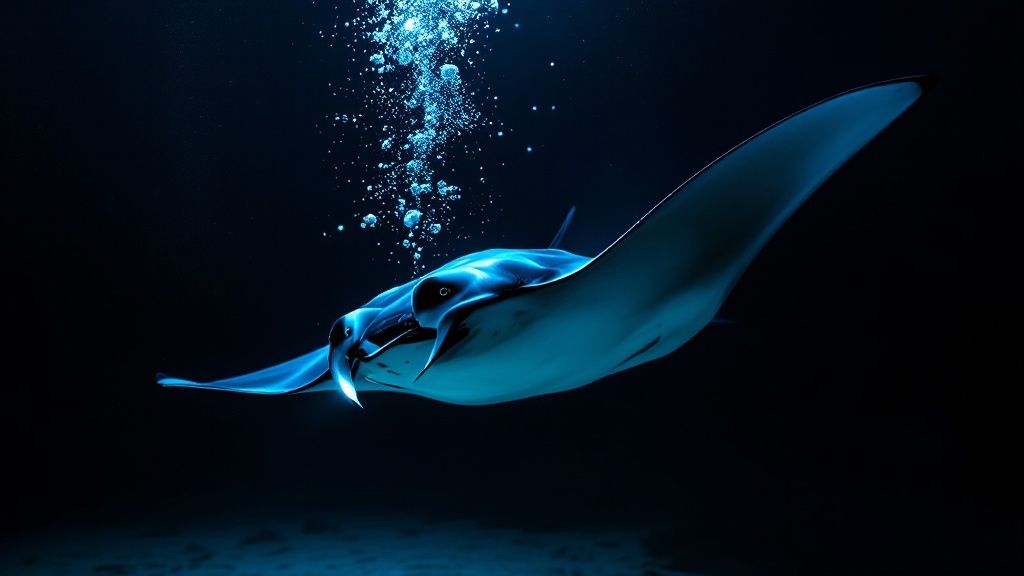
That said, some factors can make a great trip even better. The main things to think about are the ocean conditions and the weather, which play a role in water clarity and how smooth your boat ride is.
Aiming for Calm Seas and Clear Waters
While you can see mantas all year, the ocean is generally calmest and clearest from late spring through early fall. Think April to October. During these months, you’re more likely to experience glassy water and incredible visibility. It's prime time.
The winter months can bring bigger swells to the Hawaiian Islands, but Kona's west-facing coast offers a lot of natural protection. Tours still run safely and regularly, and the mantas don't seem to mind a little chop. Water temperature is also a non-issue, staying in a comfortable range between the mid-70s and low-80s Fahrenheit all year long.
The bottom line? There isn't a bad time to go. The best time for your snorkel is simply whenever you can get to Kona!
Understanding the Seasonal Nuances
Kona's specific geography and ocean currents have created a truly world-class manta ray habitat. To help you plan, here's a quick breakdown of what to expect throughout the year.
Kona Manta Snorkel Seasonal Guide
This table compares conditions for manta ray snorkeling in Kona throughout the year to help you plan your trip.
| Season | Average Water Temp | Weather Conditions | Manta Sighting Consistency |
|---|---|---|---|
| Spring (Mar-May) | 75-78°F (24-26°C) | Generally calm seas, sunny days, and less wind. | Excellent. Consistently high sightings. |
| Summer (Jun-Aug) | 78-82°F (26-28°C) | The calmest and warmest time of year. Glassy water is common. | Excellent. Peak season for calm conditions. |
| Fall (Sep-Nov) | 77-80°F (25-27°C) | Conditions remain very good, with warm water and calm seas. | Excellent. Sightings remain strong. |
| Winter (Dec-Feb) | 74-77°F (23-25°C) | Potential for larger ocean swells, but Kona is well-protected. | Excellent. Mantas are still there! |
Ultimately, the best time to book your trip depends on your personal travel plans. If you're visiting in July, you can probably count on a perfectly smooth ride. If you come in December, the boat ride might be a little more adventurous, but the manta encounter will be just as magical.
The real key is choosing a top-notch tour operator who puts safety first and knows how to handle any conditions. Book with the right crew, and you’re set for an amazing adventure any night of the year. This premier manta ray night snorkel in Kona is an experience you'll never forget.
A Safe and Sustainable Manta Encounter
When you join a manta ray snorkel, you’re stepping into their world, and the number one rule is to be a good houseguest. Every responsible tour operator in Kona is deeply committed to the long-term health of these gentle giants. This isn't just about a one-night show; it's about protecting this incredible population for decades to come.
We all follow a strict set of internationally recognized guidelines, sometimes called the 'Manta Ray Green List'. They’re simple, but they make all the difference. The biggest rule of all? No touching. It's so tempting, I know, but manta rays have a protective mucus layer—a slime coat—that acts as their shield against nasty bacteria. Touching them strips this layer away, leaving them open to infection.
Your Role as a Responsible Snorkeler
Think of yourself as a quiet observer, a visitor invited into their underwater dining room. You're there to watch the magic unfold, not to interfere. Your guides will walk you through everything you need to know beforehand to make sure the interaction is safe and respectful for everyone, mantas included.
This commitment to conservation is precisely why the experience is so consistently amazing. The incredible sighting success rate—often hovering around 85-90% on the Kona Coast—isn't just luck. It's the direct result of decades of careful study and sustainable tourism practices that put the mantas first.
By choosing a tour operator that puts the mantas’ welfare first, you become part of the solution. You're not just a tourist; you’re an ally for the ocean.
Safety Always Comes First
Of course, your safety is just as important as the mantas'. From the moment you step on the boat, you'll have professional in-water guides looking out for you. They’re experts in first aid, the local marine environment, and helping even the most nervous snorkeler feel completely at ease in the water.
Here’s what you can always expect from a top-notch tour:
- A Solid Briefing: You’ll get a full rundown of what to expect, how to use your gear properly, and the do's and don'ts of interacting with the mantas.
- Top-Quality Gear: No leaky masks here. You'll be outfitted with well-maintained snorkels, masks, and wetsuits to keep you comfortable and safe.
- Eyes on You at All Times: Guides are in the water with the group from start to finish, ready to offer a hand or answer a question.
Knowing that these safety nets are in place lets you relax and truly soak in the wonder of the experience. For a deeper dive into staying safe in the water, check out our guide on essential snorkeling safety tips.
Getting Ready for Your Manta Ray Night Snorkel
A little bit of prep work can make all the difference between a good trip and a truly great one. When you plan ahead, you can just relax and soak in the incredible manta ray ballet happening right below you.
Let’s run through a quick checklist to make sure you're all set for your big night out on the water.
The first thing to think about is post-snorkel comfort. I always recommend bringing a warm towel and a dry change of clothes. Even on a balmy Hawaiian evening, you’ll be surprised how chilly the air can feel after you get out of the ocean.
What to Pack (and What to Leave at Home)
Your tour operator will have all the essential gear covered—wetsuits, masks, snorkels, the works. But a few personal items can definitely enhance your experience. If you’re even a little worried about seasickness, it’s a smart move to take some medication before you even step on the boat.
Here's a simple packing list to get you sorted:
- A Towel: You'll be glad you have it for drying off and warming up.
- Change of Clothes: For a comfortable, dry ride back to the harbor.
- Underwater Camera: This is a moment you'll want to capture!
- Reef-Safe Sunscreen: An absolute must if you're on one of the earlier sunset tours.
That’s really all you need. It’s best to leave any bulky bags or valuables back at your hotel.
A question I get all the time is, "Do I need to be a strong swimmer?" The answer is a definite no. You'll be holding onto a large, custom-built floatation board with bright lights the entire time, so this adventure is perfect for just about anyone who's comfortable getting in the water.
Capturing the Magic
Bringing an underwater camera is a fantastic idea, but getting those perfect shots in dark water can be a real challenge. A little know-how goes a long way.
If you’re keen on taking some brag-worthy photos, it pays to learn a few tricks of the trade. For a deep dive, check out our guide on how to take underwater pictures.
Follow these simple tips, and you'll feel confident, prepared, and ready to enjoy every second of this unforgettable night.
Your Manta Ray Snorkel Questions Answered
Got a few questions before you dive in? Perfect. Let's run through some of the most common things people ask about the manta ray night snorkel in Kona. Getting these details sorted will help you feel completely ready for the adventure of a lifetime.
Is the Manta Ray Night Snorkel Safe?
Yes, it’s incredibly safe. Think of it less like an extreme sport and more like a floating light show. Every reputable tour company puts safety first, with experienced guides, top-notch flotation gear, and clear instructions before you even get in the water.
And the stars of the show? Manta rays are total gentle giants. They’re filter feeders, so they don’t have teeth, stingers, or barbs. The entire encounter is peaceful and hands-off—you just get to watch them do their thing.
Do I Need to Be an Expert Swimmer?
Not at all. You don’t need to be an Olympian to enjoy this. The whole setup is designed to be easy and accessible.
Everyone holds onto a large, custom-made light board that floats on the surface. This board provides all the support and buoyancy you need, so your only job is to relax, float, and breathe through your snorkel. If you're comfortable in the water, you're good to go.
The experience is all about passive observation. You simply float and watch the magic unfold below. It’s a very low-exertion activity that works for most people.
What Happens if We Don't See Any Manta Rays?
It's a valid question—these are wild animals, after all. The good news is that manta sightings in Kona are remarkably consistent, with a success rate that’s often over 90%. It’s one of the most reliable wildlife encounters on the planet.
That said, nature is never a 100% guarantee. To account for this, most of the best tour companies offer a "manta guarantee." If your trip happens to be one of the rare times the mantas don't show, they'll often let you come back for another tour for free. Just be sure to ask about the specific policy when you book.
Can I Touch the Manta Rays?
This is a hard no. Touching the manta rays is strictly forbidden, and for a very important reason. Their skin is covered in a protective mucus coating, which is like their immune system against infection.
Touching them can rub off this vital layer, leaving them vulnerable to bacteria and disease. The golden rule is to look, not touch. By keeping your hands to yourself, you're doing your part to protect Kona's incredible manta ray population for years to come.
Ready to see this underwater ballet for yourself? Kona Snorkel Trips runs the highest-rated manta ray night snorkel in Kona, giving you a front-row seat to one of nature's most unforgettable spectacles.
